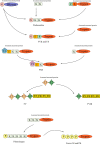Domain Evolution of Vertebrate Blood Coagulation Cascade Proteins
- PMID: 36181519
- PMCID: PMC9643190
- DOI: 10.1007/s00239-022-10071-3
Domain Evolution of Vertebrate Blood Coagulation Cascade Proteins
Abstract
Vertebrate blood coagulation is controlled by a cascade containing more than 20 proteins. The cascade proteins are found in the blood in their zymogen forms and when the cascade is triggered by tissue damage, zymogens are activated and in turn activate their downstream proteins by serine protease activity. In this study, we examined proteomes of 21 chordates, of which 18 are vertebrates, to reveal the modular evolution of the blood coagulation cascade. Additionally, two Arthropoda species were used to compare domain arrangements of the proteins belonging to the hemolymph clotting and the blood coagulation cascades. Within the vertebrate coagulation protein set, almost half of the studied proteins are shared with jawless vertebrates. Domain similarity analyses revealed that there are multiple possible evolutionary trajectories for each coagulation protein. During the evolution of higher vertebrate clades, gene and genome duplications led to the formation of other coagulation cascade proteins.
Keywords: Blood coagulation; Hemolymph clotting; Modular evolution; Protein domains.
© 2022. The Author(s).
Figures





Similar articles
-
Step-by-step evolution of vertebrate blood coagulation.Cold Spring Harb Symp Quant Biol. 2009;74:35-40. doi: 10.1101/sqb.2009.74.001. Epub 2009 Aug 10. Cold Spring Harb Symp Quant Biol. 2009. PMID: 19667012 Review.
-
Evolution of enzyme cascades from embryonic development to blood coagulation.Trends Biochem Sci. 2002 Feb;27(2):67-74. doi: 10.1016/s0968-0004(01)02007-2. Trends Biochem Sci. 2002. PMID: 11852243 Review.
-
Sirtilins - the new old members of the vitamin K-dependent coagulation factor family.J Thromb Haemost. 2019 Mar;17(3):470-481. doi: 10.1111/jth.14384. Epub 2019 Feb 13. J Thromb Haemost. 2019. PMID: 30644641 Free PMC article.
-
Genomic evidence for a simpler clotting scheme in jawless vertebrates.J Mol Evol. 2008 Feb;66(2):185-96. doi: 10.1007/s00239-008-9074-8. Epub 2008 Feb 19. J Mol Evol. 2008. PMID: 18283387
-
Domain shuffling and the evolution of vertebrates.Genome Res. 2009 Aug;19(8):1393-403. doi: 10.1101/gr.087072.108. Epub 2009 May 14. Genome Res. 2009. PMID: 19443856 Free PMC article.
Cited by
-
Tracing the paths of modular evolution by quantifying rearrangement events of protein domains.BMC Ecol Evol. 2025 Jan 8;25(1):6. doi: 10.1186/s12862-024-02347-7. BMC Ecol Evol. 2025. PMID: 39773110 Free PMC article.
-
Experimental recombining of repetitive motifs leads to large functional metallothioneins and demonstrates their modular evolvability potential.Protein Sci. 2025 Jan;34(1):e5247. doi: 10.1002/pro.5247. Protein Sci. 2025. PMID: 39673460 Free PMC article.
-
Domain-Shuffling in the Evolution of Cyclostomes and Gnathostomes.J Exp Zool B Mol Dev Evol. 2025 Mar;344(2):59-79. doi: 10.1002/jez.b.23282. Epub 2024 Dec 4. J Exp Zool B Mol Dev Evol. 2025. PMID: 39629881 Free PMC article.
-
The main protease (Mpro) from SARS-CoV-2 triggers plasma clotting in vitro by activating coagulation factors VII and FXII.Commun Biol. 2025 Aug 1;8(1):1145. doi: 10.1038/s42003-025-08570-2. Commun Biol. 2025. PMID: 40750828 Free PMC article.
-
Genetic duplication of tissue factor reveals subfunctionalization in venous and arterial hemostasis.PLoS Genet. 2022 Nov 30;18(11):e1010534. doi: 10.1371/journal.pgen.1010534. eCollection 2022 Nov. PLoS Genet. 2022. PMID: 36449521 Free PMC article.
References
-
- Chaudhry R, Usama SM, Babiker HM (2021) Physiology, coagulation pathways. In: StatPearls. StatPearls Publishing. https://europepmc.org/article/NBK/nbk482253 - PubMed
Publication types
MeSH terms
Substances
LinkOut - more resources
Full Text Sources

